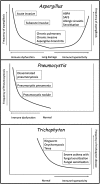Fungal allergy in asthma-state of the art and research needs
- PMID: 24735832
- PMCID: PMC4005466
- DOI: 10.1186/2045-7022-4-14
Fungal allergy in asthma-state of the art and research needs
Abstract
Sensitization to fungi and long term or uncontrolled fungal infection are associated with poor control of asthma, the likelihood of more severe disease and complications such as bronchiectasis and chronic pulmonary aspergillosis. Modelling suggests that >6.5 million people have severe asthma with fungal sensitizations (SAFS), up to 50% of adult asthmatics attending secondary care have fungal sensitization, and an estimated 4.8 million adults have allergic bronchopulmonary aspergillosis (ABPA). There is much uncertainty about which fungi and fungal allergens are relevant to asthma, the natural history of sensitisation to fungi, if there is an exposure response relationship for fungal allergy, and the pathogenesis and frequency of exacerbations and complications. Genetic associations have been described but only weakly linked to phenotypes. The evidence base for most management strategies in ABPA, SAFS and related conditions is weak. Yet straightforward clinical practice guidelines for management are required. The role of environmental monitoring and optimal means of controlling disease to prevent disability and complications are not yet clear. In this paper we set out the key evidence supporting the role of fungal exposure, sensitisation and infection in asthmatics, what is understood about pathogenesis and natural history and identify the numerous areas for research studies.
Keywords: ABPA; ABPM; Aspergillus; Corticosteroid; Eosinophil; Hypertonic saline; IgE; Itraconazole; SAFS; Severe asthma.
Figures


References
-
- Hardin BD, Kelman BJ, Saxon A. Adverse human health effects associated with molds in the indoor environment. J Occup Environ Med. 2003;45:470–478. - PubMed
-
- Bush RK, Portnoy JM, Saxon A, Terr AI, Wood RA. The medical effects of mold exposure. J Allergy Clin Immunol. 2006;117:326–333. - PubMed
-
- Stevens DA, Moss RB, Kurup VP, Knutsen AP, Greenberger P, Judson MA, Denning DW, Crameri R, Brody AS, Light M, Skov M, Maish WA, Mastella G. Allergic bronchopulmonary aspergillosis in cystic fibrosis–state of the art: cystic fibrosis foundation consensus conference. Clin Infect Dis. 2003;37(Suppl 3):S225–S264. - PubMed
-
- Knutsen AP, Bush RK, Demain JG, Denning DW, Dixit A, Fairs A, Greenberger PA, Kita H, Kariuki B, Kurup VP, Moss RB, Niven RM, Pashley CH, Slavin RG, Vijay H, Wardlaw AJ. Fungi and allergic lower respiratory tract diseases. J Allergy Clin Immunol. 2012;129:280–291. quiz 292-283. - PubMed
-
- Agarwal R, Chakrabarti A, Shah A, Gupta D, Meis JF, Guleria R, Moss R, Denning DW. Allergic bronchopulmonary aspergillosis: review of literature and proposal of new diagnostic and classification criteria. Clin Exp Allergy. 2013;43:850–873. - PubMed
LinkOut - more resources
Full Text Sources
Other Literature Sources

